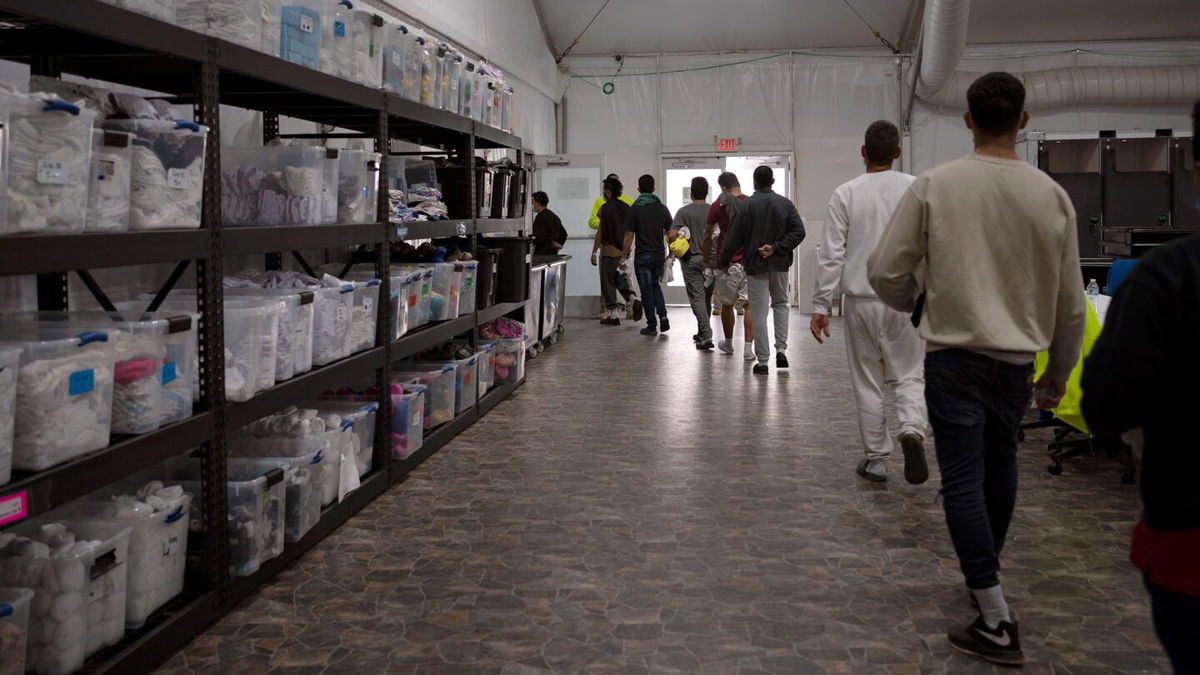Adult migrants are held in border facilities too long amid Biden administration policy changes, sources say

Migrants walk through a newly opened U.S. Customs and Border Protection soft-sided facility in El Paso
By Priscilla Alvarez, CNN
(CNN) — President Joe Biden’s new asylum policy has contributed to migrants remaining in border facilities for more than 10 days and some for up to 30 days, multiple sources told CNN, as the administration toughens its posture on the US-Mexico border.
It’s US government policy that migrants should not be held for longer than 72 hours in US Customs and Border Protection facilities, which are ill-equipped for extended stays because they’ve historically only held migrants who could be quickly returned to their origin country. Time in custody has exceeded the 72 hours over the years amid shifting demographics and has been exacerbated in recent months following the Biden administration’s return to a decades-old protocol and changes to asylum processing.
It’s a delicate issue for a White House dogged by fierce criticism from the left and right over its handling of the US southern border and remains a political vulnerability amid Republican attacks as the 2024 presidential election approaches.
Administration officials have pointed to a dramatic drop in border crossings since the end of a pandemic policy, known as Title 42, that allowed for the quick expulsion of migrants, as evidence that the administration’s approach, including increased deportations and tougher penalties, is working.
But internally, some officials argue new policies – and limited resources – are contributing to migrants remaining in border facilities for extended periods of time. And immigrant advocates and attorneys have raised alarm about the limited access to counsel for migrants seeking asylum while stuck in US Customs and Border Protection custody.
Last week, of the more than 10,000 people in CBP custody, more than 1,000 of them had been in border facilities for over 10 days across the US-Mexico border, one Homeland Security official told CNN. In some cases, migrants have been in custody for more than 25 days, another Homeland Security official said.
“We’re not built to do this,” one of the Homeland Security officials told CNN, adding that officials are monitoring the situation.
Shifting demographics, a growing number of border crossings, and limited detention capacity in recent years have contributed to people staying in CBP custody for longer than three days because of processing and limited resources.
“Unfortunately, that’s been a constant issue for years. No matter the situation, we’re usually held up by the limitations in capabilities of the next link in chain,” another Homeland Security official told CNN.
Still, migrants being held for multiple weeks marks a shift that’s causing concern. Recent policy changes, some officials argue, have contributed to extended stays. Administration officials this year started a policy intended to expedite the asylum process by requiring that some migrants remain in CBP facilities for their credible fear interviews, the first step in the asylum process. Those screenings usually happen in Immigration and Customs Enforcement facilities, which typically have spaces for the sensitive interviews and where there’s generally more access to counsel.
“CBP prioritizes for in-custody expedited removal processing those single adults from nationalities that may be removed quickly, including those who may be removed to Mexico. At times, certain circumstances – which could include the need to transfer individuals laterally due to overcrowding – could extend the amount of time individuals spend in CBP’s custody,” a CBP spokesperson said in a statement.
“CBP works to ensure individuals spend the least amount of time in custody possible while completing processing,” the spokesperson said.
The Department of Homeland Security set up soft-sided facilities, akin to a tent complex, to accommodate the increase in migrants as they’re processed. Those facilities are better equipped than the more jail-like conditions in traditional Border Patrol facilities, and include additional holding rooms, showers, and phone booths for migrants, but no beds.
Policy condemned by immigration advocates
The policy has been widely condemned by immigrant advocates and attorneys who argue that it puts asylum seekers at a disadvantage in part because it could make obtaining an attorney more difficult.
“You’re set up to fail,” said Kirsten Zittlau, an immigration attorney based in San Diego, who’s representing a Peruvian national who was in CBP custody for at least 10 days in Yuma, Arizona, while going through the new asylum process. He’s since been transferred to ICE detention and ordered removed despite claims of extortion and threats in Peru, according to Zittlau.
“First of all, how are you supposed to find an attorney, then an attorney available on weekends, then get your evidence together in no time?” Zittlau said, citing her client’s experience as an example. “I never thought I’d say there’s anything worse than ICE custody, but this is it.”
Advocates in El Paso, Texas, have also interviewed migrants released from custody who shared that they had been in border facilities for more than 20 days.
“A lot of people are confused about why they were being held,” said Patrick Giuliani, policy analyst at Hope Border Institute in El Paso.
The CBP spokesperson told CNN that the agency is working with US Citizenship and Immigration Services and the Justice Department’s Executive Office for Immigration Review to schedule appointments for credible fear interviews and “ensure that all legal requirements are met.”
Asylum officers, though, are also feeling the strain, according to Michael Knowles, spokesperson for the AFGE National Citizenship and Immigration Services Council 119, which represents over 13,000 USCIS employees, including some 1,000 asylum officers.
Knowles described officers feeling frustrated because the asylum applicants they’re interviewing in CBP custody are often tired and confused, having crossed the border only days before.
“It’s all over the place,” he told CNN. “They’re scared and they’re worried. They’re on their own to make calls. They come to the interview bewildered,” he added, referring to the migrants.
Asylum officers have also observed migrants in CBP custody for extended periods of time because of the process, which may take longer if asylum officers, who are already under strain, aren’t immediately available.
Administration officials have repeatedly argued that they’re providing new and additional avenues for migrants to enter the US legally, like a mobile app and standing up centers in the hemisphere to allow migrants to apply to come to the US. But that’s done little to quell concerns of advocates and attorneys who say changes to the asylum process and longer stays in CBP custody are harmful to migrants.
“I was pretty horrified,” Zittlau said.
The-CNN-Wire
™ & © 2023 Cable News Network, Inc., a Warner Bros. Discovery Company. All rights reserved.



